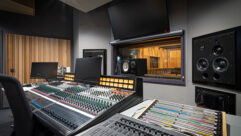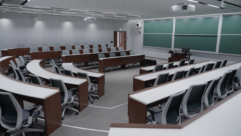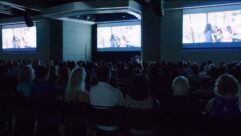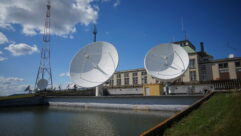Public domain
Dec 1, 1999 12:00 PM,
Sam McDonald
Supporting digital broadcast standards for the Connecticut Network ensuresa system design that will survive the implementation of HDTV.
Digital technology steadily continues to expand the horizons of systemscontractors. It seems that not a week goes by anymore without theannouncement of a new development that could present new opportunities. Arecent project for the state government of Connecticut provides one suchportal of possible opportunity to take advantage of digital technology inthe near future. The new Connecticut Network (CT-N) makes the state’slegislative sessions, held in the state capital of Hartford, available tothe TV-viewing public on a daily basis. By itself, this concept is notnovel; C-SPAN accomplished the same thing two decades ago, and almost 20other states now offer broadcasts of their legislative leaders in action.
Consider, however, that CT-N’s system has been designed specifically to beready for impending digital broadcast standards. All switching anddistribution elements were designed from the outset to be compatible withserial digital signal and operate both in the current 4:3 analog standardand 16:9 high-definition television (HDTV) format. The fact that such arelatively low-profile application as a state government broadcast hasalready committed to this future – even while major market broadcastingoutlets struggle to bring their digital facilities on line – could be animportant indicator of the near future.
“We’re on the verge of a logical progression to increased proliferation ofdigital broadcasting at a number of levels,” said Rich Gibbs, director ofbroadcast sales at HB Communications, North Haven, CT, which partnered withthe Connecticut Public Affairs Network to develop the systems for CT-N.”Certainly there’s already a good amount of video and broadcast-typeactivity by systems contractors in areas such as videoconferencing anddistance learning, and the house of worship market increasingly seeks toutilize video for recording, and in certain situations, for transmission aswell. It’s foreseeable that digital broadcast tools could soon be viable inthese applications.”
Established more than 50 years ago, HB Communications provides a wide rangeof design and installation services, including specialties in fixedinstallation and broadcast applications. A recent focus has been inpresentation systems, with a current project of this type ongoing at theMystic Aquarium in Mystic, CT.
Gibbs credits the staff of the Connecticut Public Affairs Network, headedby president and CEO Paul Giguere, for the push to a digital-ready solutionnow rather than waiting until it becomes mandatory. Although nearly $1million in state funds were allocated for equipment purchases, it is aninitial investment that will not have to be duplicated, which would havebeen the case with an analog-only approach.
For their money, approximately 60% of Connecticut cable TV-connectedhouseholds can view live and live-to-tape sessions of both the House andSenate sessions of the state general assembly along with select publichearings. The program feed is supplied to several Community CollegeInstructional Television (CCIT) channels in the state, and it can also beviewed live with a Windows-based multimedia player on CT-N’s Web site,www.ctn.state.ct.us.
“Although it may superficially seem that digital equipment is overkill forwhat might be termed lower-level broadcast and even non-broadcastapplications, it’s a good idea to take a closer look,” Gibbs said.”Already, we’re seeing prices dropping dramatically, and logically, thiswill only escalate. At the same time, it already provides a quantum leapforward in terms of quality, flexibility and reliability.”
Essentially, then, this indicates a trend toward digital broadcast andvideo technology’s soon becoming viable for higher-end systemsapplications, say, for example, in videocon-ferencing on the corporatelevel. In fact, boardrooms are already being outfitted with 16:9 plasmascreens to accommodate current digital playback formats. One piece of thepuzzle is already being realized.
Budgets and understanding may also soon make digital broadcast technologymore widespread among distance-learning systems in the educational market.Also, as evidenced by CT-N, there is already a general awareness of thedigital issue at the state level, which will logically filter down to thelocal level. Further projection: Mainstream systems contracting could alsopresent increased opportunities in the design and installation of digitalbroadcast systems. The aforementioned house of worship market is onenotable market in this regard; the ability to provide a quality digitalbroadcast on a local affiliate or cable access channel helps houses ofworship fulfill their goals of reaching larger audiences.
One of the looming issues in this scenario, of course, is the Internet.Significantly upgraded capability for data transmission on the Internet,promised to be on its way, may completely change the way we think aboutbroadcasting. The college or high school that wants a new sound system forits gymnasium may also soon be interested in a small-scale digitalbroadcasting system to distribute its games to viewers – particularlyalumni – around the planet. Churches may find this method an attractive,cost-effective way not only to reach parishioners who may have moved away,but also to increase their presence locally, perhaps to shut-ins or evenhospitals.
All systems under a scenario of this type, whether it be in a corporateheadquarters or high school gym, would in all likelihood be established ona network with centralized control from a single location. Of particularinterest to the systems contractor, this network and the individualelements on it would be remotely addressable from anywhere in the worldwith Internet access, including the con-tractor’s office. In fact, we arealready seeing increased implementation of this type of networking withhigher-end, digitally controlled audio and routing systems. With all ofthis in mind, let’s have a look at the system established for digitalbroadcasting by CT-N. It could very well offer some clues as to what’scoming.
Both the House and Senate chambers, ensconced within the state capitolbuilding, are outfitted with Sony DXCD30WSL digital processing wide-screen(16:9) color cameras, switchable to 4:3 aspect ratio (their currentsetting). Three cameras are strategically positioned in the House, and fourcover the Senate. All are mounted on Crestron’s CPC-CAMI network-connected,remotely controllable pan/tilt units that also include lens control.
All of these cameras, as well as the pan/tilt units, terminate in anequipment room on the fifth floor of the building. From there, feeds aretransferred to a single-mode fiber optic link (provided by the state) thattakes them to Panasonic WV-BM503 monochrome video monitors mounted in amaster control room carved into a legislative office building down thestreet. Meanwhile, three identical camera/pan/tilt combinations can be setup in any of 10 hearing rooms, all properly wired and linked monitors tothe control room. Cameras are simply moved around and plugged in on an asneeded basis.
Two identical system operation positions were established in the controlroom. “Both of these stations offer the capability to control the House,Senate and hearing room systems simultaneously, so there’s redundancy,”Gibbs said. “However, when things are in full swing in the capitol, there’stoo much for one person to handle, so each operator position is manned bytwo people.”
Each position includes a Grass Valley Model 1200 component digitalproduction switcher (also 16:9 compatible), which enables quick, seamlesschanging between cameras. Meanwhile, the pan/tilt and lens control unitsare controlled with Crestron CPC-2000 master control units, offeringtouchscreen selection and dual joystick controls for fine tuning the aim,zoom and focus of each camera.
“The House, with 156 members, can be tough to cover. Presets areestablished on the Crestron control unit that allow the operator to zoom inon a group or individual quickly, so essentially it’s just a push of thescreen and then tailoring with the joystick,” Gibbs said. Another operatorat each position is responsible for running a Pinnacle Write Deko broadcastcharacter generator, used to identify speakers and to provide viewers withother useful information such as ongoing vote tallies.
Three Sony DNW-75 BetacamSX digital recorders each offer three hours ofrecording time on tape, but the most important recording element is aTektronix PDR324D MPEG-2 digital recorder providing 72 GB of storage. It iscapable of simultaneous record and playback; for example, if a sessionbegins at 3:50 p.m., but the broadcast is scheduled to begin at 4 p.m., theoperators can start the broadcast on a 10 minute delay while stillrecording the session as it proceeds.
Because the two operation positions are independent, one session can bebroadcast while the other is recorded. Six Sony PVM-14M2U 14 inch (357 mm)monitors allow preview and character generator review. The control room isfilled out with a complement of other routing switchers as well as analogand digital system test equipment.
No editing is done at any time, Giguere said, adding that the principlepoint of CT-N is to provide citizens with a first-hand account of thelegislative process without the information being filtered by news sources.”It’s as if you’re in the room. No one is going to tell you what to think,”he said.
Audio in the House and Senate chambers is captured from existing housesystems, consisting of Auditel multi-mixers fed by mics at eachlegislator’s desk. A feed from each of the two multimixers is routed toMackie MS-1402-VLZ audio consoles for fine-tuning with one channeldedicated to a mic for announcements and voice-overs done at the operatorpositions. “The sound quality, in general, is pretty good, although we’realways at the mercy of the mic techniques of each individual,” Gibbs said.
>From the control room, programming is distributed, again via state-suppliedfiber lines, to the local Southeast New England Telephone Company switchingcenter, where it is then supplied to CCIT for broadcast. Also from thecontrol room, a feed is supplied to an encoder for Internet broadcasting.
Both Giguere and Gibbs concur that CT-N will grow. Plans and the necessaryinfrastructure are already in place to mount remotely controlled cameras inall 10 hearing rooms permanently. Further, the network would like to deviseportable systems to be able to broadcast sessions and meetings not held inthe capital building. An ultimate goal is to cover more than the state’slegislative branch. Talks are currently ongoing with the state SupremeCourt, and it is possible that court proceedings could be broadcast by nextyear.
Although the CT-N situation may go beyond the scope of what most systemscontractors can or want to provide, Gibbs definitely sees parallels betweenthis project and future opportunities. “Contractors who want to providesystems at this type of a broadcast level must have expertise, and it maynot be worth the effort and expense to get there,” he said, “but a lot ofthese systems at the cable level are not as critical, although they willcertainly employ similar concepts and technologies. It’s also logical toproject that technology and systems of this type, fueled by digitaldevelopments, will be attractive to a wide range of mainstream systemscontracting customers.”










